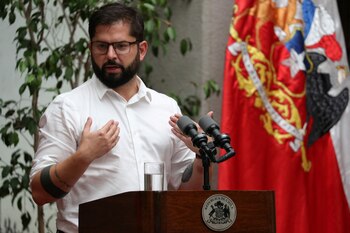
Gabriel Boric presented this Thursday an economic recovery plan for $3.7 billion, which seeks the creation of 500,000 new jobs and freezes public transport fares, among other measures.
When the Chilean economy begins to show signs of slowdown after reaching in 2021 - in a rebound after the pandemic - the largest expansion since records (11.7%), the president announced a package of 21 measures, called “Chile Activa”.
“We know that this recovery plan is a starting point. Big changes are not achieved overnight, and in order for them to be sustainable over time, they must be responsible in their implementation,” said the president of Chile, at the presentation of the plan in a neighborhood in western Santiago.
The initiative envisages the mobilization of resources amounting to $3.7 billion. Some 1.3 billion will be direct contributions to the pockets of families; 1.4 billion will be used to generate employment and support lagging sectors, and about 1 billion to support micro, small and medium-sized enterprises, explained the head of state.
The economic program also provides for the freezing of public transport fares throughout 2022 - impacted by the global increase in oil - and the containment of the value of fuels.
In 2021, Chilean GDP expanded 11.7%, driven by the increase in private consumption following social assistance provided by the State to cope with the pandemic and three early withdrawals from pension funds approved by Congress.
The strong injection of liquidity, coupled with the rise in international commodity prices, simultaneously triggered inflation, which is expected to reach 10 percent by the middle of the year.

In this scenario, the Chamber of Deputies is preparing to discuss next week a new early withdrawal of private pension funds, which the Boric government opposes.
Last week, the Central Bank reduced its estimates of Chile's GDP growth to a range of 1-2% from a previous one of 1.5-2.5%, due to the fact that since the end of 2021 the Chilean economy would be reducing its high levels of spending “at a somewhat faster rate than expected.”
The unemployment rate, meanwhile, stands at 7.5 per cent.
For its part, the Consumer Price Index (CPI) accumulated 7.8% in February in 12 months and the issuer expects it to reach 8.2% this year, well above the tolerance range.
The Monthly Economic Activity Indicator (Imacec) for February, which is considered an advance in monthly GDP, disappointed markets with a fall of 0.7% compared to January and recorded the lowest year-on-year growth in almost a year (6.8%).
Manuel Agosín, an economist at the University of Chile, told the EFE agency that the increase in CPI in Chile is in line with the rest of the world countries and is due to “short-term” causes such as the war in Ukraine, the increase in prices of raw materials and social assistance and early withdrawals from pension funds, that in 2021 they skyrocketed consumption.

“What is really worrying is not the rise in prices, but we already have early indicators of an upcoming economic crisis, a crisis not because of inflation but because of recession,” he said days after the issuer reduced growth projections for 2022 from a high of 2.5% to 2%.
In the same vein, Hernán Díaz, economist at the University of Talca, believes, who also pointed out that the Chilean situation “is very far from that of Argentina or Venezuela, whose inflation has a political or structural origin.”
Diaz added that “considering that growth for the coming years will be low, there will be a cooling of the economy and lower inflation.”
According to the bank, economic stagnation “is happening at a somewhat faster rate than expected” and will continue in 2023, when GDP will only grow between 0.25% and 0.75%.
(With information from AFP and EFE)
Keep reading:
Últimas Noticias
Debanhi Escobar: they secured the motel where she was found lifeless in a cistern

The oldest person in the world died at the age of 119

Macabre find in CDMX: they left a body bagged and tied in a taxi
The eagles of America will face Manchester City in a duel of legends. Here are the details

Why is it good to bring dogs out to know the world when they are puppies



